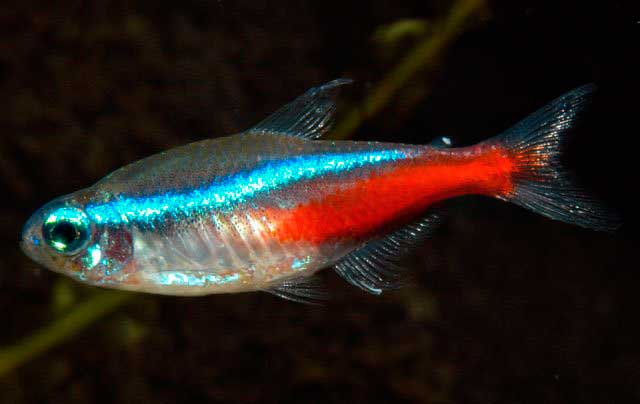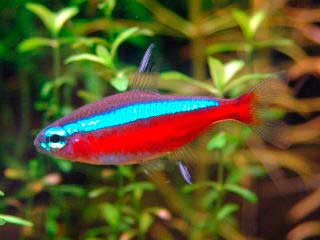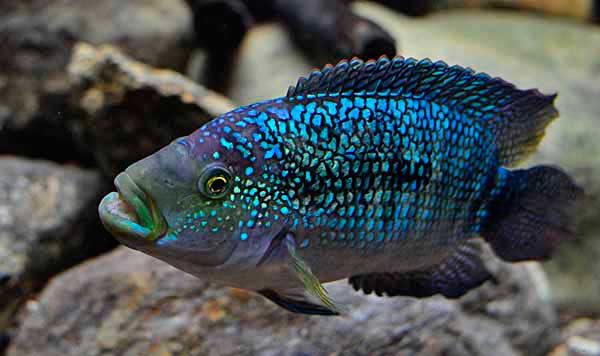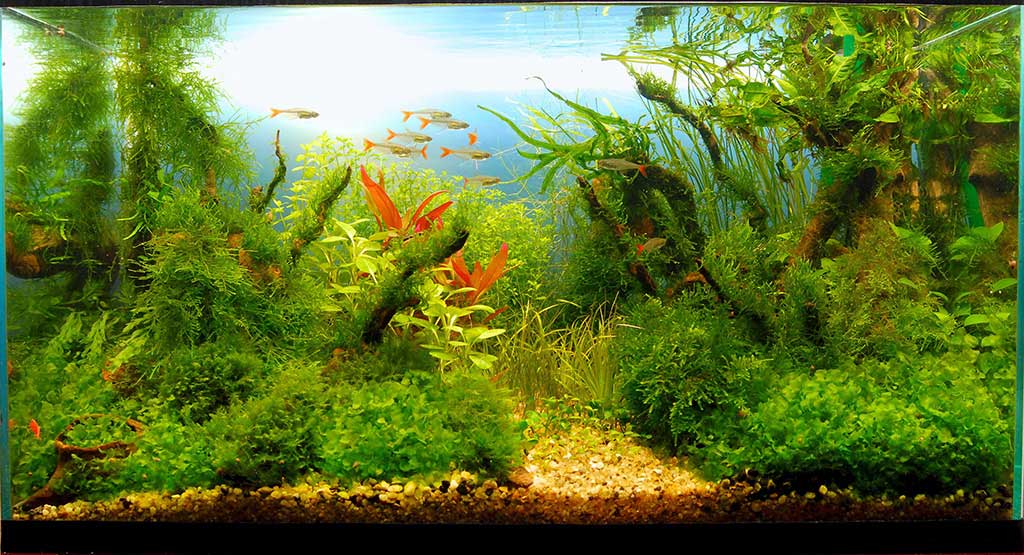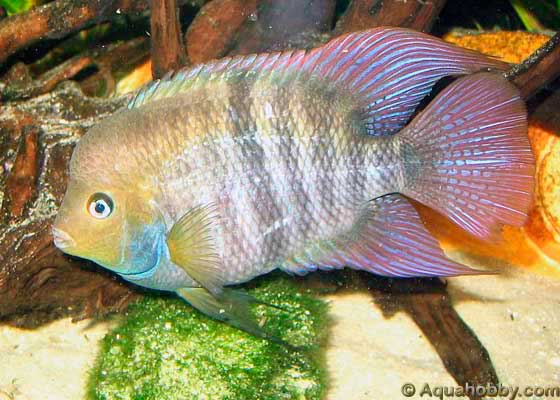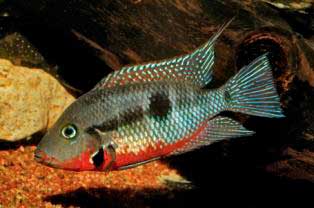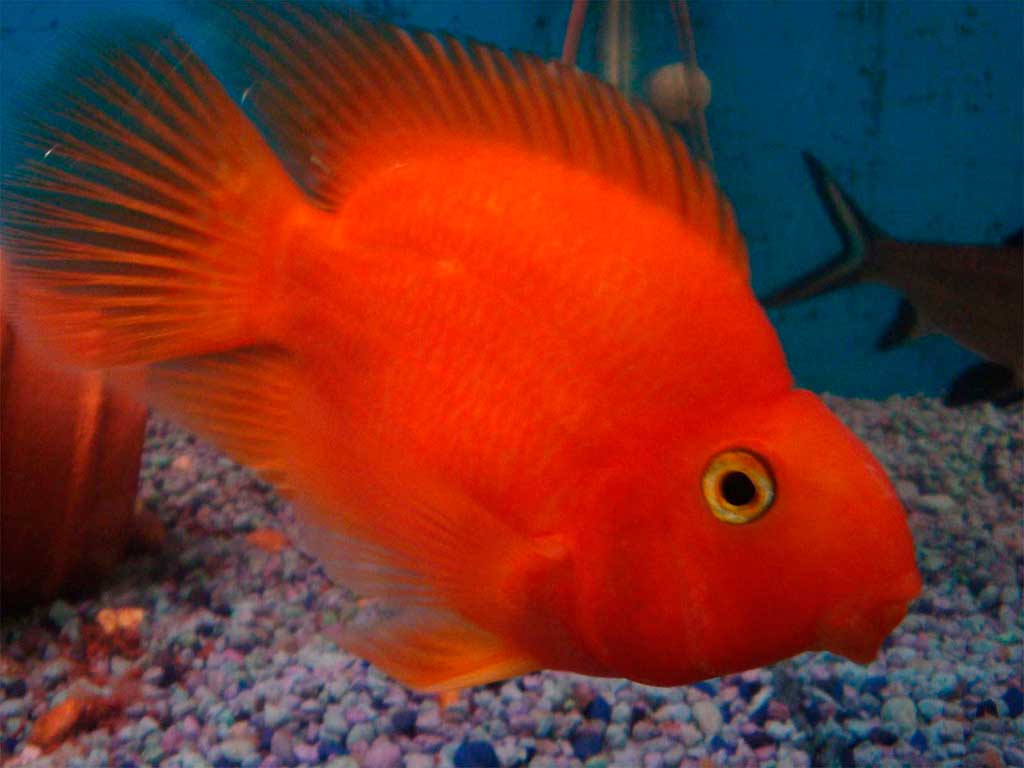Hyphessobrycon innesi is known to aquarists relatively recently. Since it was discovered in nature, it has won the hearts of more than one generation of aquarists. Its unusual bright coloring is able to revive any aquarium. A relatively simple care for this fish allows you to recommend it to contain novice aquarists.
| domain | Eukaryotes |
| kingdom | Animals |
| type | Chordates |
| class | Radiant fish |
| division | Characiniformes |
| Family | Characins |
| genus | Neons |
| species | Hyphessobrycon innesi |
Латынь: Paracheirodon innesi
Synonyms: Neon, common neon, neon fish, Hyphessobrycon innesi.
The Hyphessobrycon innesi was first discovered in the Amazon jungle waters in 1934 by French traveler August Rabaut. Auguste Rabaut was fascinated by the small brightly colored fish he caught, and he decided to bring them to Europe for sale. Thus in Europe this species appeared between 1934 and 1936. Here the blue neon came to William T. Innes, a well-known popularizer of aquaristics at that time. William Innes in turn gave these fish to his colleague George Myers for study. George Meer published the first article on the Hyphessobrycon innesi in the Washington Bulletin of the Biological Society. Meer named the new species in honor of his friend from whom he received these fish – Hyphessobrycon innesi. Some time later, Hyphessobrycon innesi was renamed Paracheirodon inessi. In the Soviet Union, blue neon first appeared in 1955.
Neons inhabit the upper Amazon in Peru, mainly between Iquitos, the largest city in the Peruvian Amazon, and São Paulo de Olivens of Amazonas state. The Hyphessobrycon innesi is most often found in the left tributary of the Amazon Putumayo, as well as the right tributary, which has its source on the eastern slope of the Andes – Purus. It is also found in the Ucayali River.
Description of the Hyphessobrycon innesi
Probably, if I say that this is one of the most beautiful aquarium fish, everyone will agree with me. It is a small fish up to four centimeters long. Along the body from the eye to the tail fin goes a bright shiny azure stripe. Below this stripe, the back half of the body is colored bright red. The back of the fish is olive, the belly is silvery. The fins are transparent.
This fish is gregarious. It is best to keep a flock of at least seven – ten fish. Fish mobile and when the flock is carried around the aquarium, its azure stripe reflects the light, creating a non-transferable game of light. Best of all, the fish looks on the background of dark soil. And it is desirable aquarium, decorated in a tropical style. Most of the time the fish is kept in the lower and middle layers of water. In aquarium conditions live Hyphessobrycon innesi three to four years.
Sexual dimorphism is not pronounced, but with some experience there is usually no difficulty. Males can be distinguished from females by their smaller size and straight azure line. Females are somewhat larger than males. They have a more rounded abdomen and the median azure stripe has a slight bend approximately in the middle of the body.
Hyphessobrycon innesi aquarium maintenance
In the content neons are unpretentious. For a flock of ten tails is sufficient aquarium volume of ten liters. Paracheirodon innesi are not demanding to the chemical composition of water for normal content. Water temperature should be about 20-23 ° C. The pH is 7. Water hardness can be in the range of 5 – 17 °dH.
It is also relatively easy for them to tolerate the lack of oxygen. Although it is desirable to arrange a small fountain of rising bubbles. This will create a small current of water mass and bring the conditions behind the glass aquarium to their native places.
Hyphessobrycon innesi preferred food
Of the feeds are desirable small. Small moths, daphnia. Large worms, such as pipe worms should be slightly crushed, so that the fish could swallow this tidbit. When using pipe worms should be aware of the rules of its use, so as not to infect any fish. Although Paracheirodon innesi prefer live food, but can eat frozen and dry food. It should only when choosing food to take into account that the fish prefers to take food in the water column, can take from the surface, but it should still get used to it.
To everything else it is very delicate aquarium fish. If its neighbors in the aquarium will be less well-mannered, your neon risk at best to sit on a starvation ration, and in the worst case may even die of hunger. Therefore, during the feeding should be sure to monitor whether the neons take the food that you offered them and do not take away their food other fish.
Unpretentious in content and peaceful disposition make this fish suitable for keeping in a common aquarium. But once again it should be emphasized that the neighbors in a common aquarium should also be extremely peaceful. You can try to keep with them guppies, danio rerio, ternecia.
Aquarium decoration
Plants are suitable for any plants that you like more. You can use to decorate the aquarium vallisneria, elodea, cladophora, pistole, some types of cryptocoryne. It is desirable at the back corners of the reservoir to create a small thicket. Also welcome is the presence of floating on the surface of the water plants with hanging roots. You can also use ritchia and cassava.
Almost any substrate that does not change the chemical composition of water is suitable as soil. Coarse river sand, fine gravel, small pebbles are quite suitable. Preference should be given to a substrate without sharp edges, dark shade. Against the background of such soil Hyphessobrycon innesi look the most attractive.
The plants and you need the extra light, but not the neons. They do not like bright light. Keep this in mind when selecting a light fixture. For an aquarium of 20 liters, an economical discharge lamp with a power of 6 W will be sufficient.
Hyphessobrycon innesi breeding
Preparatory activities
Neon breeding is almost an art. Hyphessobrycon innesi reach sexual maturity at six to seven months. Weeks before two males and females are desirable to separate and keep separately. During this period, they should be heavily fed live feed.
It is recommended to use small all-glass tanks of 5 -10 liters as a spawning ground. First of all, it is necessary to take care of the chemical composition of the water. Preparation of water is recommended to start a week before the proposed spawning. Water needs to be crystal clear. It is desirable that it is a week to stand in a darkened aquarium. Darkness prevents the development of algae. And such a long retention guarantees the absence of chlorine or other reagents used for disinfection of water at water intake stations. Water should be soft. Hardness 0.5 – 4 °dH. If the water in the spawning tank will be harder, the shell of the eggs will become impermeable and the seed of males will not be able to fertilize them. Because of this feature for a relatively long time could not get offspring from neon in artificial conditions.
Water should have a slightly acidic reaction pH 5 – 6.5. Water temperature is maintained at 22 – 24 ° C. As a substrate for spawning is used twig or a small bush of peristolistnika, a bundle of willow roots taken from the water. Even better to cover the bottom of the net with a mesh with a side of about three millimeters. This will keep the eggs from being eaten by the parents.
The actual spawning
After all the preparatory work will be done in the aquarium in the evening put a couple of producers. Although it is better to be insured and take one female and two males or several males and females. It should only take into account that the more producers you plan to attract to the continuation of the family, the larger the size should be spawning tank.
Early in the morning, when the aquarium is illuminated by the weak light of the new day, spawning will begin. During spawning a pair of producers will lay from 40 to 170 eggs. After spawning producers are immediately removed. And the spawning ground must be completely shaded. Eggs illuminated by direct light rays are doomed to death.
The larvae emerge after 24 hours. And for the next five days they hang on the spawning walls. All this time, the spawning tank should be shaded. Only on the sixth day after spawning from the aquarium can be slightly removed from the shade and start feeding fry pre-prepared tiny food (infusoria, rotifers). At about the same time fry preferably transferred to a more rigid, clean, settled water. All changes in the environment, including lighting should be carried out gradually without hurrying.
Because of the difficulties in breeding, for a long time neons could not be bred in artificial conditions. And today this task for patient and careful aquarists. I hope you, dear reader, this task will be able to do.
